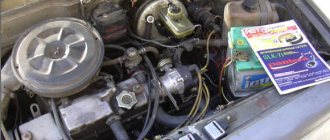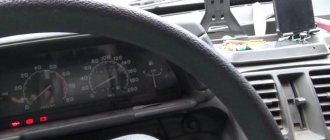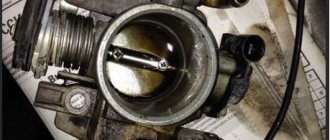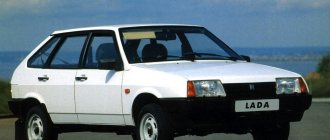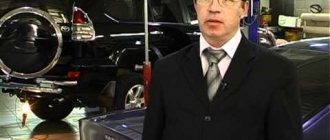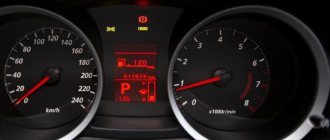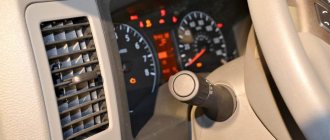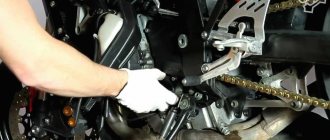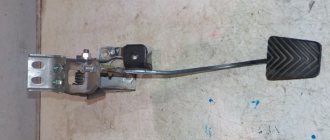If the engine stalls when you press the clutch, this may be due to various reasons. Starting from the breakdown of sensors and ending with the incorrect operation of the main components and assemblies of the machine. We will talk about solving these problems in this article.
Most common reasons
Cleaning the throttle valve
Replacing the idle speed sensor
Changing the fuel filter
Video “Guide to Replacing the Fuel Filter”
Comments and Reviews
Most common reasons
First, let’s look at why, when you press the clutch pedal or when braking, the car’s injection system malfunctions and the engine stalls:
- Failure of the idle speed controller. If the car stalls when you press the pedal, you need to diagnose this sensor. This can happen both while driving and at the beginning of the movement. When the driver increases idle speed by pressing the gas, the engine recovers and continues to function. But if the power of the power unit does not increase, the engine stalls again. To solve the problem, you need to check the functionality of the controller, the integrity of the electrical circuit, and also clean the contacts on the connector. If this does not help, the sensor must be replaced.
- Malfunction in the throttle assembly. When you push in the clutch and brake, a clogged throttle body can cause the engine to stall. This unit in a vehicle is used to regulate the volume of the air-fuel mixture that is formed in the engine. Due to poor quality gasoline and other factors, the valve sometimes becomes clogged. To avoid problems when the internal combustion engine stalls when the clutch is depressed, it is recommended to use only high-quality fuel. The only solution to the problem is to clean the damper. If the unit is worn out and cannot perform its functions even when cleaned, it must be replaced.
- A problem occurs when the driver presses the clutch pedal to change speed or presses it while braking, the engine begins to “trouble” and eventually stops. The malfunction is often associated with a failure of the throttle position controller. If cleaning the damper does not help solve the problem, you need to diagnose the sensor. Most manufacturers do not regulate the replacement of this device, since the controller is installed for the entire service life of the vehicle. But the sensor can fail and lead to the problem of spontaneous shutdown of the power unit. It is necessary to diagnose the controller, check the integrity of the contacts on the connector and the wiring. If these elements are intact and cleaning the plug does not help, the device must be replaced.
- Malfunction of the fuel filter device. When the filter's service life comes to an end, it begins to work incorrectly. Often its malfunction is associated with the regular use of low-quality fuel. If the filter becomes clogged, the speed drops, and the car may stall not only when the clutch is depressed, but also when driving in gear. Cleaning the device may solve the problem, but not for long. It's better to change it.
- Malfunction of the fuel pump. If the device breaks down, it will be impossible to start the car engine. But if the pump does not work correctly, but still performs its functions, then the engine will periodically stall. Malfunctions in its operation occur as a result of the constant use of low-quality fuel. To solve the problem, the device is checked and repaired. If the pump is broken, it must be replaced.
- The generator device may also be causing the problem. A breakdown of this unit will result in all electrical appliances in the car being powered by the battery. If the generator set fails, the engine may stall randomly. But such a problem actually happens quite rarely.
The Mir Matizov channel in its video offers a more detailed look at the reasons for the engine stopping.
avtoexperts.ru
No matter what kind of car you have, expensive and reliable, absolutely no one is immune from the fact that one fine day, in the morning before going to work, it may simply stall immediately after starting. In this essay we will try to cover all theoretically and practically possible causes of this trouble.
What usually happens is this: you turn the key in the ignition, the engine starts, a few seconds pass, and the revolutions on the tachometer rapidly drop down to zero, and eventually the engine stalls.
First of all, you need to understand the reason.
Surprising as it may be, check the presence of fuel in the tank, since the liquid level sensor could simply have failed and you simply ran through all the gasoline, and the car did not inform you about its low balance.
If you are sure that the fuel level is OK, then try to restart the engine.
When you try to start again, listen to the operation of the pump; the electrical power circuit may be interrupted, or there may be a mechanical failure. If the pump hums, it pumps fuel to the fuel rail, and that's good.
The next step is to check how the air flows. To do this, remove the casing on the air filter and check it for critical contamination. If the filter is in order, we put it back in the box and check the rubber air supply pipes.
If everything is in order with them, then the only simple thing you can remember is removing the positive terminal from the battery for a short time so that the information on the electronic control unit is updated and all active errors are erased.
If this does not help, then you can no longer cope with the problem on your own and you need to contact the service for qualified help.
But what could be the reasons that the engine starts and then stalls?
1. Loss of power supply to the sensors or their failure. For example, such as MAF (Mass Air Flow Sensor), crankshaft position sensor, EGR, or throttle position sensor.
2. The spark on the spark plugs is insufficient for stable operation of the internal combustion engine. The reason may lie in insulation breakdowns on the armor wires, failed ignition coils or ignition distribution module, and finally, in the spark plugs themselves.
3. If your car has a diesel engine, and the temperature outside drops below -10 degrees, then there is a high probability that the glow plugs have failed.
4. If your car has an additional alarm system with an immobilizer bypass module, then there is a possibility that the standard electrical system is in conflict with a foreign one. If all anti-theft systems have not undergone any intervention, you still need to check the standard immobilizer for correct operation. If the immobilizer does not read the code from the key, it does not turn off, then the car thinks that it is being stolen, and the electronics turns off the engine.
5. The engine may stall due to improper operation of the injectors, or their complete failure. The fuel simply does not enter the combustion chamber.
6. The throttle valve requires cleanliness, and its contamination can also be the reason why the engine immediately stalls after starting
This is especially worth paying attention to in regions with poor fuel quality.
7. Well, finally, the worst thing is a malfunction of the gas distribution mechanism. If you have a timing belt drive (gas distribution mechanism), then everything is simple. If not done correctly, it will simply break. But if your camshafts are driven by a chain, then everything is a little more interesting. The chain tends to stretch, and therefore can jump on the gears, due to which the intake and exhaust valves may begin to operate incorrectly, and a failure may occur either during the intake of the fuel-air mixture, or during the release of exhaust gases, due to why the car may stall, may not start at all, or may simply run unstably.
The simplest reason for a failed start may be poor quality fuel or fuel diluted with water. In this case, in an amicable way, after draining the unknown substance from the fuel tank, you need to completely flush the entire fuel system and replace the fuel filter.
Well, the simplest thing that can be recommended to ensure that the car is always in order is to refuel only at proven gas stations and periodic preventive visits to the service center for diagnostics. A car is a complex mechanism, but even it does not break down instantly. A good half of the breakdowns could have been prevented in the early stages.
Solution
The procedure to correct the problem depends on the type of problem. If the engine stalls when you press the clutch or brake on a car with an injector, you can solve the problem yourself. Let's consider all cases of troubleshooting.
Cleaning the throttle valve
To complete the task, you will need a special cleaning agent; it can be purchased at any automotive store. There are many types of cleaners, you can choose something to suit your budget. The procedure for dismantling the unit depends on the design features of the car; it can be performed in different ways.
Throttle valve before and after cleaning
Let's consider the removal process using the Daewoo Lanos model as an example:
- Open the hood of the car and remove the damper. To do this, loosen the clamps securing the air supply hose and remove it. Disconnect the wiring connectors from the idle speed controller and throttle position control.
- Disconnect the assembly control drive cable.
- Using pliers, pull the clamps off the damper heating hoses. There is no need to disconnect the hoses. Unscrew the expansion tank cap to relieve pressure in the system, then tighten it. Dismantle the pipes one by one to prevent refrigerant leakage from the system, and close the resulting holes. This will require M10 bolts.
- Using a 12 or 13 socket wrench, depending on the size of the bolts, unscrew the parts securing the throttle device. Carefully dismantle the assembly, while trying not to damage the sealing element. Assess its condition. If necessary, the rubber band is replaced with a new one if it is very worn.
- Using a Phillips head screwdriver, remove the two bolts securing the idle speed controller to the throttle body. There is a gasket on the sensor, don't lose it.
- You can now perform rinsing. Take the purchased product and use it to clean the unit, including all channels. You can also wash the idle speed sensor. Clean the air lines, as well as the calibrated positive crankcase ventilation duct. Usually it is its contamination that leads to malfunctions in the operation of the internal combustion engine. To clean it you will need a pin or needle.
- Assemble the device and check how the power unit operates.
Stalls when you release the clutch
The car was parked for 2 days and I decided to drive 2 km to the store. I drive up to the house, park, put the car into gear, release the clutch and it just stalls.:o After driving it I realized that it stalls when in the car with the clutch pedal released. There is a button under the pedal, I pressed it (the clutch pedal was pressed) and the car stalled! Maybe someone knows something.
Last edited by Romus1984; 06/27/2011 at 12:30 pm.
lop
, of course, this is how it should be, don’t be scared, just then - press the clutch, turn on the speed and the car starts again.
This is a start-stop system, which at traffic lights and in traffic jams can sometimes save up to 3 liters per hundred square meters. In Russia it was not officially installed on the Fiesta, but in Europe more than half of the cars are equipped with this.
The engine stalls when you press the clutch: why does this happen?
Let us immediately note that if the car stalls when you press the clutch, there can be many reasons for the malfunction. Moreover, in most cases, if you press the clutch pedal a little, then the power unit operates relatively stably. Let's figure it out, focusing on the most common problems.
If you monitor the tachometer, the revolutions when you press the clutch drop to such a low value that the engine stalls. By the way, the problem may not appear all the time, that is, it is often a so-called “floating” fault. Drivers also note that a drop in speed can also occur if engine braking occurs, and the clutch pedal is not pressed at this moment.
So, it becomes clear that the car often stalls when you press the clutch at the moment when the gas pedal is released. In other words, the problem occurs in transition mode, when the gas is released and the throttle valve is closed, that is, the idle system is responsible for the operation of the engine.
- First of all, on many cars, similar problems are caused by the failure of the idle speed sensor. Moreover, often after a cold start the car idles normally, but later when driving after squeezing the clutch the speed drops and the engine stops.
If, while coasting, you take your foot off the gas, squeeze the clutch or press the brake, and the speed immediately drops significantly, in most cases this indicates that the XX sensor is faulty and needs to be replaced.
First, the driver sharply presses the gas, raising the speed, then quickly depresses the clutch and engages the desired gear. This allows you to change gears before there is a strong drop in speed when you press the clutch.
- Another common cause of malfunction is often the throttle valve. In this case, the problem is due to the fact that the throttle assembly is heavily dirty or damaged.
To fix the problem, it is necessary to clean the throttle valve or replace failed elements. It should be remembered that on many modern cars the throttle body should also be trained after cleaning or other manipulations with the throttle.
- If the throttle assembly is clean and fully operational, then you should pay attention to the throttle position sensor (TPS). This sensor transmits data to the computer about how far the damper is open or closed.
If the readings differ from the actual position of the damper, then the system begins to work incorrectly. In such a situation, it is necessary to check and replace the sensor.
- Provided that no problems are found with the throttle assembly, you should proceed to checking the power system. First of all, it is necessary to assess the condition of the air and fuel filter.
It happens that their severe contamination becomes the reason why in the idle mode there is not enough fuel or air to prepare the “correct” working mixture.
- Then the injection nozzles are checked. Often, dirty injectors can supply an insufficient amount of fuel to the cylinders at different operating modes of the internal combustion engine.
Video “Guide to Replacing the Fuel Filter”
The channel In Sandro's garage, using the example of tenth generation VAZ cars, offers to familiarize yourself with the process of changing the filter device, described in the video.
The second day I observe a strange effect: when I press the clutch on a well-warmed engine (car A100, AAR 2.3 liter, 1991), the XX speed begins to fall and tends to fall almost to zero, they pass the “point” when the car almost stalls, then they jump sharply to the required 700-800. All this creates a lot of inconvenience, incl. at all sorts of intersections. Please tell me what could be causing it, where to look, what to wash/change?
To post a reply you must log in or register.
The car stalls when the clutch is depressed: do-it-yourself repair
As a rule, some of the problems associated with a stalling engine can be solved independently in a regular garage. The owner of many cars can clean the throttle himself, replace the fuel pump, filters, spark plugs, high-voltage spark plug wires, ECM sensors, etc.
Let's look at the most common operations in relation to gasoline cars. These include replacing the idle speed sensor or IAC (idle speed control). Note that on different cars the installation location of these elements may differ, but the replacement itself is almost identical.
- The first step is to remove the terminals from the battery. Next, it is determined where the XX sensor is located. Then a chip with wires snaps off from it, which is secured with a latch. Next, unscrew the screws securing the regulator from the throttle pipe, after which the element is removed.
- Now the new sensor is put in place. During installation, it is important to ensure that the rubber sealing elements on the sensor (if any) fit tightly to the surfaces.
- Now the sensor, after installation and connection, needs to be calibrated. To do this, you need to connect the terminals to the battery and turn on the ignition for 5-15 seconds. Then the ignition is turned off, after which you can test run the internal combustion engine.
After dismantling the unit, the throttle valve and channels should be washed with a cleaning fluid. Please note that you also need to blow out the crankcase ventilation channel (this can be done using a compressor by supplying air under pressure into the channel).
Also, during the process of removing the throttle, you need to carefully inspect the rubber seals of this unit. If the gasket is damaged, deformations, cracks, tears and other defects are noticeable, then the element needs to be replaced.
The throttle position sensor may also need replacement. To replace the TPS, you need to find this element (often it is located on the throttle pipe). The sensor is attached with ordinary screws that can be unscrewed with a screwdriver.
After this, a new sensor is installed in place. Typically, replacing the TPS solves the problem when the car stalls when you press the clutch, when braking the engine, or when you press the brake pedal.
- As for fuel air filters, they also need to be inspected and changed if necessary. Replacing the air filter is not difficult, since you just need to unscrew the cover of the filter housing, remove the old filter element and install a new one. The main thing is to choose the correct size air filter and place it sideways.
Next, you need to find a fuel filter (on different cars it is installed in the engine compartment, in the lower part of the car outside on the bottom, in the area of the gas tank, etc. Often the filter is attached with steel clamps, screwed with screws, etc. Fuel filters are also attached to the filter housing pipes that are removable. Keep in mind that gasoline may leak out of the filter when removed.
When installing a new filter, there should be arrows on the housing that indicate how to correctly position the filter element. The arrows should show the direction of fuel movement from the fuel tank to the engine.
After installing the filter and tightening all the fasteners, turn on the fuel pump by reinstalling the fuse, then you can turn on the ignition for 3-5 seconds so that the fuel pump raises the pressure in the system. After this, the engine can be started.
When the engine is running, you need to again inspect the installation location of the fuel filter. No fuel leaks are allowed at the connection point of the fuel pipes or along the filter housing.
What's the result?
Taking into account the above information, it becomes clear that most often the engine stalls when the clutch is depressed due to problems with idle speed. As you know, the IAC and throttle position sensor are responsible for idling.
Finally, we note that the car can stall even after the LPG installation has been carried out. In this case, it is necessary to contact the installation service so that qualified specialists make all the necessary settings of the gas equipment and the corresponding adjustments to the gas equipment.
The main reasons why the engine starts to stall after warming up. Frequent problems of carburetor and injection engines, fault diagnosis.
The engine stalls at idle: what to check. Possible causes of malfunction on engines with a carburetor, injector, and diesel power plants.
At idle the speed “floats”: why does this happen? The main malfunctions associated with idle speed on gasoline and diesel engines.
The car engine starts and stalls immediately after starting: the main causes of this malfunction. Diagnosis of possible causes, tips and recommendations.
Floating engine idle speed when cold. Basic malfunctions, symptoms and identification of breakdowns. Unstable idling of the diesel engine.
Causes of difficult “cold” starting of a diesel engine. Compression, glow plugs, diesel injectors, injection pump, paraffin or water in the fuel system.
Bad firmware
Sometimes car owners try to improve the technical characteristics of the car by flashing it. Quite often, competent firmware can add horsepower to a car and make it more dynamic. However, firmware does not always improve the dynamic characteristics of the car; sometimes the opposite happens. Some software changes improve engine performance at crankshaft speeds above 1000 rpm, and at lower speeds the engine may stall. In general, illiterate firmware can be the answer to the question of why the car stalls while driving. In this case, the injector simply “does not understand” how often and in what quantities to supply the fuel mixture.
If such a malfunction appears after installing new firmware, then it is worth resetting the on-board computer to factory settings. And the problem will go away.

